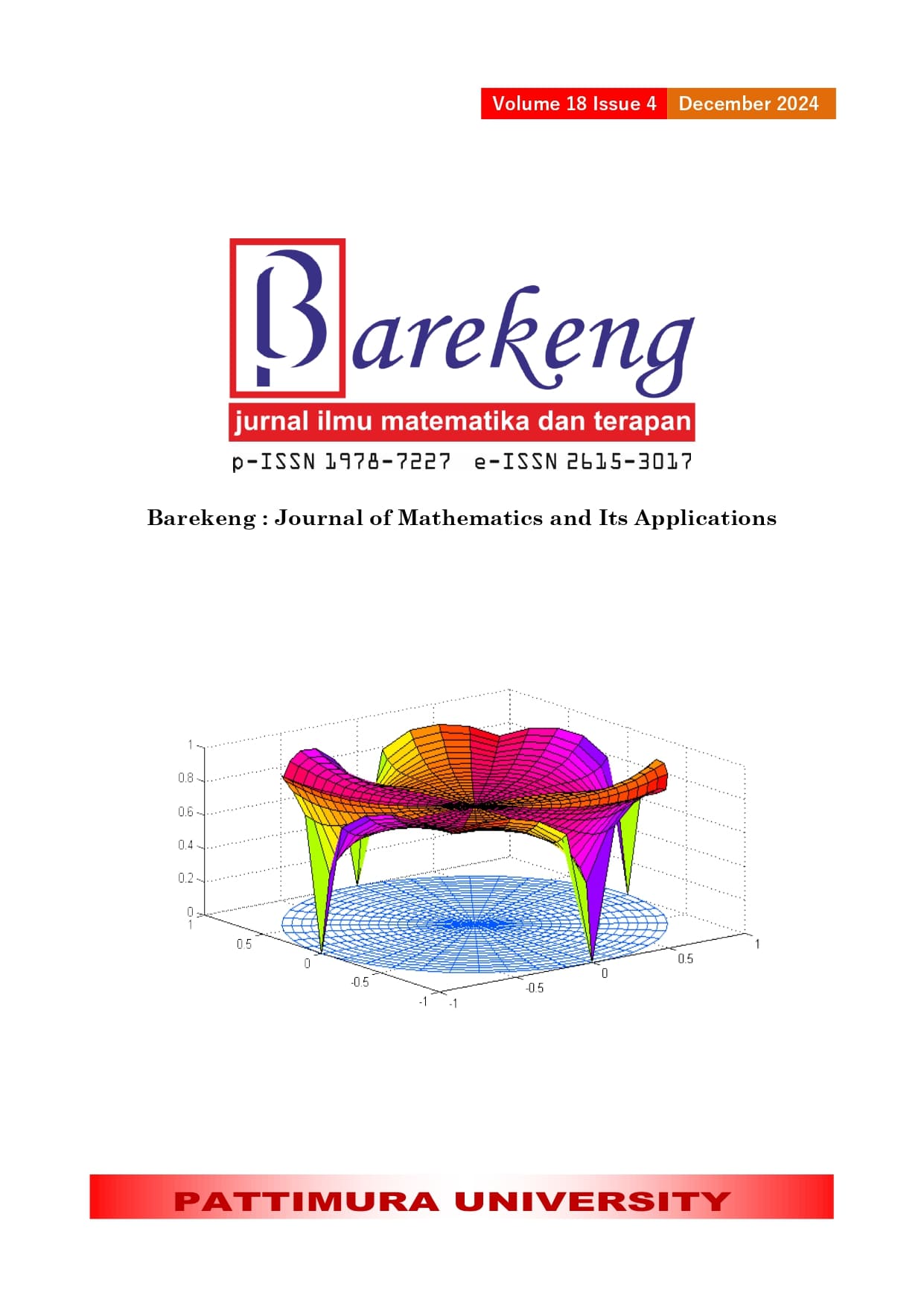PM10 AIR QUALITY INDEX MODELING USING ARFIMA-GARCH METHOD: BUNDARAN HI AREA OF DKI JAKARTA PROVINCE
Abstract
Air quality is an essential factor in urban life, and its’ assessment often relies on the concentration of measurable air pollution parameters. One critical parameter is Particulate Matter (PM), particularly PM10, which comprises solid or liquid particles dispersed in the air from various sources. One of the methods employed for predicting stock index prices is ARFIMA. ARFIMA is used to model long memory data characterized by a slowly decreasing Autocorrelation Function (ACF) plot (hyperbolic) or a difference value in the fractional from. This method is widely used due to its ability to handle nonstationarity issues in time series. However, the time series data often contain heteroskedasticity problems. Data with heteroscedasticity are then further addressed using the GARCH model, because it can model volatility changes occurring over longer periods and capture the persistence of volatility. The ARFIMA-GARCH model can explain long-memory patterns in time series data and address heteroscedasticity issues. The data are sourced from the Jakarta open data web, which is integrated with DLH DKI Jakarta Province. The aim of this research was to forecast the PM10 air quality index at the Bundaran HI Area in the Province of DKI Jakarta for the next 14 days, from January 1st to January 14th, 2021, using an ARFIMA model enhanced with GARCH. The analysis reveals that the best model is ARFIMA ([17], d, [1])-GARCH (1,1). Forecasting using this model resulted in a MAPE of 3.47%, indicating that the model is highly capable of forecasting several periods.
Downloads
References
M. N. Lingkungan Hidup, Keputusan Menteri Negara Lingkungan Hidup No. 45 Tahun 1997 Tentang : Indeks Standar Pencemar Udara. 1997.
P. Kartikasari, H. Yasin, and D. A. I. Maruddani, “Autoregressive Fractional Integrated Moving Average (ARFIMA) Model To Predict Covid-19 Pandemic Cases In Indonesia,” MEDIA STATISTIKA, vol. 14, no. 1, pp. 44–55, Jun. 2021, doi: 10.14710/medstat.14.1.44-55.
R. S. Tsay, Analysis of Financial Time Series Second Edition. New Jersey: John Wiley & Sons, Inc, 2005.
L. F. Prihastari, “Mengonstruksi Model Peramlaan Kasus Positif Covid-19 Varian Delta Menggunakan Model ARIMA-GARCH,” 2022.
K. Burnecki and G. Sikora, “Identification and validation of stable ARFIMA processes with application to UMTS data,” Chaos Solitons Fractals, vol. 102, pp. 456–466, Sep. 2017, doi: 10.1016/j.chaos.2017.03.059.
I. M. Ghani and H. A. Rahim, “Modeling and Forecasting of Volatility using ARMA-GARCH: Case Study on Malaysia Natural Rubber Prices,” in IOP Conference Series: Materials Science and Engineering, Institute of Physics Publishing, Aug. 2019. doi: 10.1088/1757-899X/548/1/012023.
T. Rizqiyah and I. Rosyida, “Analisis Cluster Tingkat Kualitas Udara Ambien Jalan Raya di Jawa Tengah Tahun,” PRISMA, Prosiding Seminar Nasional Matematika, vol. 4, pp. 560–564, 2021, [Online]. Available: https://journal.unnes.ac.id/sju/index.php/prisma/
S. Makridakis, Wheelwright, and McGee, Metode dan Aplikasi Peramalan Edisi Kedua. Jakarta: Erlangga, 1999.
W. W. S. Wei, Time Series Analysis: Univariate and Multivariate Methods, 2nd ed. New Jersey: Pearson Prentice Hall, 2006.
D. Rosadi, Analisis ekonometrika & runtun waktu terapan dengan R : aplikasi untuk bidang ekonomi, bisnis, dan keuangan. Yogyakarta: Andi, 2011.
J. R. M. Hosking, “Fractional Differencing,” Biometrika, vol. 68, no. 1, p. 165, Apr. 1981, doi: 10.2307/2335817.
N. Rismawati and S. Sugiman, “Long Memory Volatility Model dengan ARFIMA-HYGARCH Untuk Meramalkan Return Indeks Harga Saham Gabungan (IHSG),” Unnes Journal of Mathematics, vol. 11, no. 1, pp. 80–91, 2022, doi: 10.15294/ujm.v9i1.36464.
E. M. Y. Wu and S. L. Kuo, “Air quality time series based GARCH model analyses of air quality information for a total quantity control district,” Aerosol Air Qual Res, vol. 12, no. 3, pp. 327–339, Jun. 2012, doi: 10.4209/aaqr.2012.03.0051.
P. J. Brockwell and R. A. Davis, Introduction to Time Series and Forecasting, 2nd ed. United States of America: Spinger, 2002.
P. Schmitt, J. Mandel, and M. Guedj, “A Comparison of Six Methods for Missing Data Imputation,” J Biomet Biostat, vol. 6, no. 1, pp. 1–6, 2015, doi: 10.4172/2155-6180.1000224.
Y. Dong and C.-Y. J. Peng, “Principled missing data methods for researchers,” Springer Plus, pp. 1–17, 2013, Accessed: Jun. 16, 2023. [Online]. Available: http://www.springerplus.com/content/2/1/222
E. Hartini, “IMPLEMENTATION OF MISSING VALUES HANDLING METHOD FOR EVALUATING THE SYSTEM/COMPONENT MAINTENANCE HISTORICAL DATA,” J. Tek. Reaktor. Nukl, vol. 19, no. 1, pp. 11–18, 2017.
Solikhin and S. Khabibah, Buku Ajar Metode Numerik. Semarang: UPT UNDIP Press Semarang, 2014.
R. H. Shumway and D. S. Stoffer, Time Series Analysis and Its Applications With R Examples, 2nd ed. New York: Springer, 2006.
Y. Hong and Y.-J. Lee, “A General Approach to Testing Volatility Models in Time Series,” JMSE, vol. 2017, no. 1, pp. 1–33, 2017, doi: 10.3724/SP.J.1383.201001.
Copyright (c) 2024 Susilo Hariyanto, Salsabila Gustia Wibawa, Solikhin Solikhin

This work is licensed under a Creative Commons Attribution-ShareAlike 4.0 International License.
Authors who publish with this Journal agree to the following terms:
- Author retain copyright and grant the journal right of first publication with the work simultaneously licensed under a creative commons attribution license that allow others to share the work within an acknowledgement of the work’s authorship and initial publication of this journal.
- Authors are able to enter into separate, additional contractual arrangement for the non-exclusive distribution of the journal’s published version of the work (e.g. acknowledgement of its initial publication in this journal).
- Authors are permitted and encouraged to post their work online (e.g. in institutional repositories or on their websites) prior to and during the submission process, as it can lead to productive exchanges, as well as earlier and greater citation of published works.






1.gif)



